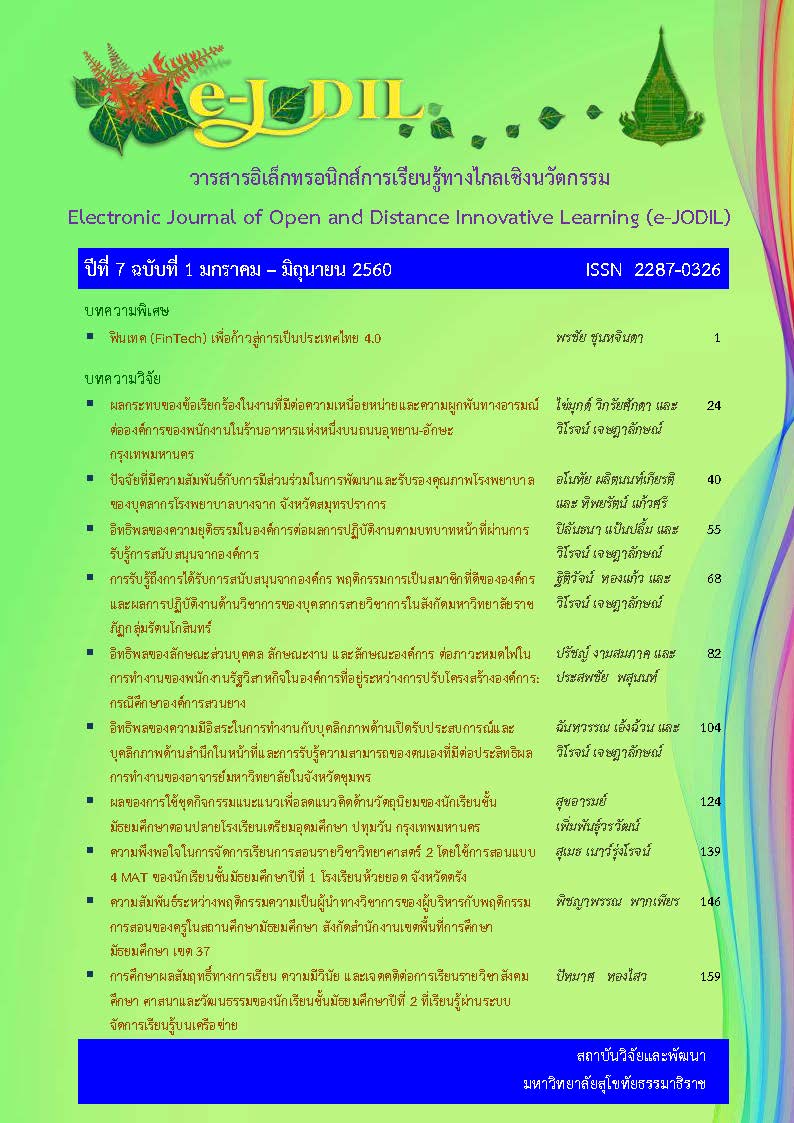ฟินเทค (FinTech) เพื่อก้าวสู่การเป็นประเทศไทย 4.0
Main Article Content
บทคัดย่อ
เทคโนโลยีทางการเงิน หรือฟินเทค (FinTech) กำลังได้รับความสนใจอย่างกว้างขวางในหลายประเทศ
ทั่วโลก เนื่องจากมูลค่าเพิ่มที่จะเกิดแก่ธุรกิจ และความสามารถทางการแข่งขันของประเทศที่จะสูงขึ้น จากการนำนวัตกรรมดังกล่าวไปสร้างบริการทางการเงินชนิดใหม่ และพัฒนาประสิทธิภาพของบริการทางการเงินที่มีอยู่เดิม ทั้งยังมีความเป็นไปได้ที่เทคโนโลยีทางการเงินเหล่านี้ จะถูกนำไปประยุกต์ใช้ให้เกิดประโยชน์ในกิจกรรมด้านอื่นๆ อย่างกว้างขวาง ด้วยเหตุนี้ การสร้างนวัตกรรมทางการเงินจากธุรกิจฟินเทค จึงตอบสนองนโยบายของรัฐบาลไทย ที่ต้องการขับเคลื่อนประเทศไทยให้เข้าสู่ยุค 4.0 อย่างไรก็ตาม แม้ว่าภาครัฐ และภาคเอกชนไทย จะมีความตื่นตัวในธุรกิจฟินเทค แต่การศึกษาทางวิชาการที่สร้างความเข้าใจในธุรกิจฟินเทคในประเทศไทย ยังมีอยู่อย่างจำกัด บทความนี้ จึงมีวัตถุประสงค์เพื่อสร้างแหล่งข้อมูลอ้างอิงที่ส่งเสริมความเข้าใจ ให้แก่ผู้มีส่วนเกี่ยวข้องกับธุรกิจฟินเทคในประเทศไทย โดยผลการศึกษาพบว่า ระบบนิเวศทางธุรกิจฟินเทคของประเทศไทย มีจุดเด่นที่สำคัญ คือ ความเชี่ยวชาญในงานบริการของคนไทย แต่ก็ยังมีประเด็นสำคัญอีกหลายประการที่จะต้องได้รับการปรังปรุง และพัฒนาอย่างเร่งด่วน เพื่อให้ผู้ประกอบการในประเทศไทยสามารถแข่งขันกับต่างประเทศได้ เช่น ความ
ไม่ชัดเจนของกฎระเบียบ การขาดแคลนบุคลากร และความอ่อนแอด้านการสร้างนวัตกรรมภายในประเทศ
Downloads
Article Details
บทความ ข้อความ ภาพประกอบ ตารางประกอบ ที่ตีพิมพ์ในวารสารเป็นความคิดเห็นและความรับผิดชอบของผู้เขียนแต่เพียงผู้เดียว ไม่เกี่ยวข้องกับมหาวิทยาลัยสุโขทัยธรรมาธิราชแต่อย่างใด
บทความที่เสนอพิจารณาในวารสาร e-JODIL ต้องเป็นบทความที่ไม่เคยส่งไปลงพิมพ์ เผยแพร่ หรืออยู่ระหว่างการพิจารณาของวารสารอื่น
กองบรรณาธิการขอสงวนสิทธิ์ในการพิจารณาและตัดสินการตีพิมพ์บทความในวารสาร
เอกสารอ้างอิง
สภาวิจัยแห่งชาติ. (2559). (ร่าง) ยุทธศาสตร์งานวิจัยเศรษฐกิจไทย เรื่อง “เทคโนโลยีทางการเงิน (ฟินเทค) กับการพัฒนาระบบการเงินไทย”.
สถาบันวิจัยเพื่อการพัฒนาประเทศไทย. (2559). New Development Model: โมเดลใหม่การพัฒนาเศรษฐกิจไทย.
ส่วนบริหารและพัฒนาเทคโนโลยีการทะเบียน สำนักบริหารการทะเบียน. (2559). สถิติประชากรและบ้าน – จำนวนประชากรแยกรายอายุ. กรมการปกครอง กระทรวงมหาดไทย.
สำนักงานคณะกรรมการพัฒนาการเศรษฐกิจและสังคมแห่งชาติ (สศช.). (2559). ร่างแผนพัฒนาเศรษฐกิจและสังคมแห่งชาติ ฉบับที่ 12 (พ.ศ. 2560 - 2564). สำนักนายกรัฐมนตรี.
Allen F., and Babus A. (2008). Networks in Finance. Wharton Financial Institutions Center. Working Paper No. 08-07.
Barrdear J., and Kumhof M. (2016). Staff Working Paper No. 605: the Macroeconomics of Central Bank Issued Digital Currencies. Bank of England.
Bose I., and Mahapatra R. (2001). Business Data Mining — A Machine Learning Perspective. Information & Management. 39 (3). pp. 211 – 225.
Chen H., Chiang R., and Storey V. (2012). Business Intelligence and Analytics: From Big Data to Big Impact. MIS Quarterly. 36 (4). pp. 1165 - 1188.
Duarte J., Siegel S., and Young L. (2012). Trust and Credit: The Role of Appearance in Peer-to-Peer Lending. Review of Financial Studies. 25 (8). pp. 2455 – 2484.
EY. (2016). UK FinTech on the Cutting Edge: An Evaluation of the International FinTech Sector. HM Treasury (United Kingdom).
Fintechranking. (2016). Infographics: Global FinTech Landscape. Web site: http://fintechranking.com /2016/08/04/infographics-global-fintech-landscape/
Froomkin M. (1997). The Internet as a Source of Regulatory Arbitrage. Borders in Cyberspace. Brian Kahin and Charles Nesson, eds. (MIT Press 1997).
Härle P., Havas A., and Samandari H. (2016). The Future of Bank Risk Management. McKinsey & Company.
Harvey C. (2016). Cryptofinance. National Bureau of Economic Research.
Hendershott T., Jones C., and Menkveld A. (2011). Does Algorithmic Trading Improve Liquidity?. Journal of Finance. 66 (1). pp. 1 – 33.
Hendershott T. and Riordan R. (2013). Algorithmic Trading and the Market for Liquidity. Journal of Financial and Quantitative Analysis. 48 (4). pp. 1001 - 1024.
Houston J., Lin C., and Ma Y. (2012). Regulatory Arbitrage and International Bank Flows. Journal of Finance. 67 (5). pp. 1845 – 1895.
KASIKORN Business-Technology Group (KBTG). (2559). KBTG: Technology Focus.
Lin M., Prabhala N., and Viswanathan S. (2012). Judging Borrowers by the Company They Keep: Friendship Networks and Information Asymmetry in Online Peer-to-Peer Lending. Management Science. 59 (1). pp. 17 – 35.
Lusardi A. and Mitchell O. (2011). Financial Literacy and Planning: Implications for Retirement Wellbeing. Working Paper. National Bureau of Economic Research.
Mollick E. (2014). The Dynamics of Crowdfunding: An Exploratory Study. Journal of Business Venturing. 29 (1). pp. 1 – 16.
Murphy D., Shrieves R., and Tibbs S. (2009). Understanding the Penalties Associated with Corporate Misconduct: An Empirical Examination of Earnings and Risk. Journal of Financial and Quantitative Analysis. 44 (1). pp. 55-83.
Rodriguez J. (2007). Measuring Financial Contagion: A Copula Approach. Journal of Empirical Finance. 14 (3). pp. 401–423.
Sangroya A., Kumar S., Dhok J., and Varma V. (2010). Towards Analyzing Data Security Risks in Cloud Computing Environments. Communications in Computer and Information Science. 54. pp. 255 – 265.
Skinner C. (2016). The Five Major Use Cases for Financial Blockchains. Brave New Coin.
Tambunlertchai K. (2015). Financial Inclusion, Financial Regulation, and Financial Education in Thailand. ADBI Working Paper Series. Asian Development Bank Institute.
Venture Scanner. (2016). Financial Technology Market Overview – Q4 2016. Web site: https://venturescannerinsights.wordpress.com/tag/venture-capital/
Williams-Grut O. (2016). WEF: Here are the 6 Biggest Risks in FinTech. Business Insider. World Bank. (2016). Thailand Overview 2016.
World Economic Forum. (2015). The Future of Financial Services: How Disruptive Innovations are Reshaping the Way Financial Services are Structured, Provisioned and Consumed.
World Intellectual Property Organization (WIPO). (2016). WIPO Patent Report: Statistics on Worldwide Patent Activity. The World Bank.
Wyman O. (2016). The Role of Financial Services in Society: Understanding the Impact of Technology- Enabled Innovation on Financial Stability. World Economic Forum.
Zhang X., Wuwong N., Li H., and Zhang X. (2010). Information Security Risk Management Framework
for the Cloud Computing Environments. 2010 10th IEEE International Conference on Computer and Information Technology.


